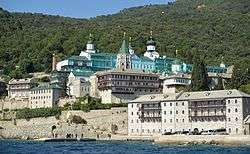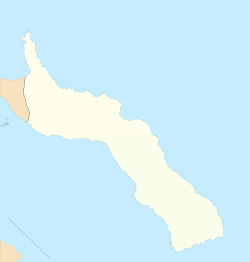St. Panteleimon Monastery
Saint Panteleimon Monastery (Russian: Монастырь Святого Пантелеймона; Greek: Μονή Αγίου Παντελεήμονος, Moní Agíou Panteleímonos), known as Rossikon (Russian: Россикон, Rossikon; Greek: Ρωσσικόν, Rossikón) or New Russik (Russian: Новый Руссик, Novyy Russik), is one of the twenty Eastern Orthodox monasteries on Mount Athos, located on the southwestern side of the peninsula in Northern Greece. It is often referred to as "Russian" and does have historical and liturgical ties to the Russian Orthodox Church; nevertheless, like all the other monastic settlements on Mount Athos, the monastery is under the direct ecclesiastical jurisdiction of the Ecumenical Patriarchate of Constantinople and all its monks are citizens of Greece, usually naturalized.
Άγιος Παντελεήμων | |
 | |
 Location within Mount Athos | |
| Monastery information | |
|---|---|
| Full name | Holy Monastery of Agiou Panteleimonos |
| Other names | Rossikon (Russian) |
| Order | Ecumenical Patriarchate of Constantinople |
| Dedicated to | St. Panteleimon |
| Diocese | Mount Athos |
| Prior | Eulogius (Ivanov) |
| Site | |
| Location | Mount Athos, Greece |
| Coordinates | 40°14′13″N 24°12′07″E |
| Public access | Men only |
History
The monastery was founded by several monks from Kievan Rus in the 11th century, which is why it is known as "Rossikon". It has been inhabited by mainly Russian monks in certain periods of its history. It was recognized as a separate monastery in 1169.
Russian pilgrim Isaiah confirms that, by the end of the 15th century, the monastery was Russian.[1]
The monastery prospered in the 16th and 17th centuries being lavishly sponsored by the tsars of Moscovy and Serbian dukes of Kratovo, but it declined dramatically in the 18th century to the point where there were only two Russian and two Bulgarian monks left by 1730.
The construction of the present monastery on a new site, closer to the seashore, was carried out during the first two decades of the nineteenth century, with the financial help of the ruler of Moldo-Wallachia, Skarlatos Kallimachos. Russian monks numbered 1,000 in 1895, 1,446 in 1903, and more than 2,000 by 1913. During the Tatar yoke in Russia, most of the monks were Greeks and Serbs. The monastery occupies the nineteenth rank in the hierarchical order of the twenty Athonite monasteries. It is coenobitic (i.e., it is a communal monastic life). It also contains four sketes.
In 1913, the monastery was the site of a raging theological argument (Imiaslavie) among Russian monks, which led to tsarist Russian intervention and the deportation of approximately 800 of the monks on the losing side of the debate.[2]
The Monastery of St Panteleimon was repeatedly gutted by fires, most famously in 1307 (when Catalan mercenaries set it aflame) and in 1968. The first Russian leader to visit the monastery was President Vladimir Putin on September 9, 2005.
In the modern era
Today, the monastery features the architecture of a small town, with buildings of various heights and many domes. It is the largest of the monasteries on the peninsula.[3] Although destroyed by a fire in 1968, one wing of the monastery was used as the guest quarters, with a capacity of 1,000 monks. The monastery's katholikon (main church) was built between 1812–1821 and is dedicated to St. Panteleimon. It features the same style found in all the Athonite churches. Aside from the katholikon, the monastery has many smaller chapels.
The library is housed in a separate building in the monastery's court. It contains 1,320 Greek manuscripts and another 600 Slavonic ones, as well as 25,000 printed books. In addition, the library has a few priceless relics, such as the head of Saint Panteleimon, one of the most popular saints in Russia. The 19th-century monastery bells are said to be the largest in Greece. There is a daughter community at the monastery at New Athos, Abkhazia.

After the transfer of Athos to the Kingdom of Greece in 1912, and especially with the start of World War I in 1914, the stream of pilgrims and monks from Russia was disrupted and later was strictly controlled by the government of Greece until the collapse of the USSR in 1991. As a result, the number of Russian monks in the monastery and on Mount Athos generally, was reduced from several thousand in the 1900s to 13 in the early 1970s.
In the 1990s, Greece relaxed its restrictive policy and the monastery has since undergone a relative revival. As of May 2016, there are approximately 70 Russian and Ukrainian monks.[2]
Some manuscripts
- Uncial 052
- Minuscule 1093 (Gregory-Aland)
Notable monks
Notable former monks of the monastery include Silouan the Athonite and Archimandrite Sophrony.
References
- A. E. Bakalopulos (1973). History of Macedonia, 1354-1833. [By] A.E. Vacalopoulos. p. 166.
At the end of the 15th century, the Russian pilgrim Isaiah relates that the monks support themselves with various kinds of work including the cultivation of their vineyards....He also tells us that nearly half the monasteries are Slav or Albanian. As Serbian he instances Docheiariou, Grigoriou, Ayiou Pavlou, a monastery near Ayiou Pavlou and dedicated to St. John the Theologian (he no doubt means the monastery of Ayiou Dionysiou), and Chilandariou. Panteleïmon is Russian, Simonopetra is Bulgarian, and Karakallou and Philotheou are Albanian.
- ERASMUS (29 May 2016). "Greece, Russia and religious diplomacy". The Economist. Retrieved 31 May 2016.
- Norman, Edward (1990). The House of God: Church Architecture, Style and History. Thames & Hudson. p. 70. ISBN 978-0-500-28556-5.
External links
| Wikimedia Commons has media related to Moni Agiou Panteleimonos (Athos). |
